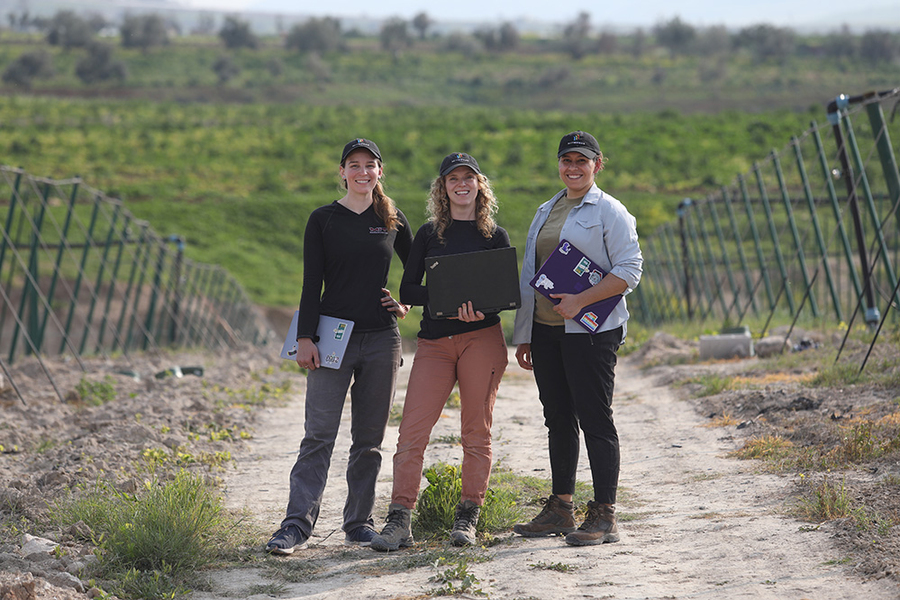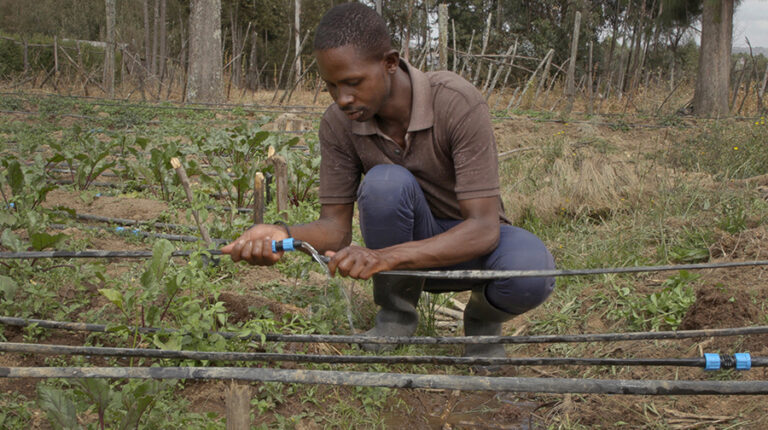The Global Engineering and Research (GEAR) Lab at MIT has developed low-cost, solar-powered irrigation tools to make precision agriculture more accessible.
GEAR Lab has created several drip irrigation technology solutions, including a low-pressure drip emitter that has been shown to reduce pumping energy by more than 50% when compared with existing emitters; a systems-level optimization model that analyzes factors like local weather conditions and crop layouts, to cut overall system operation costs by up to 30%; and a low-cost precision irrigation controller that optimizes system energy and water use, enabling farmers to operate the system on an ideal schedule given their specific resources, needs and preferences. The controller has recently been shown to reduce water consumption by over 40% when compared with traditional practices.
The controller, for example, takes in weather information like relative humidity, temperature, wind speed values and precipitation. Then, using artificial intelligence, it calculates and predicts the area’s solar exposure for the day and the exact irrigation needs for the farmer, and sends information to their smartphone. How much, or how little, automation an individual site uses remains up to the farmer. In its first season of operation on a Moroccan test site, GEAR Lab technology reduced water consumption by 44% and energy by 38% compared with a neighboring farm using traditional drip irrigation practices.
In agriculture today, robots and drones can monitor fields, temperature and moisture sensors can be automated to meet crop needs, and a host of other systems and devices make farms more efficient, resource conscious and profitable. The use of precision agriculture, as these technologies are collectively known, offers significant advantages. However, because the technology can be costly, it remains out of reach for the majority of the world’s farmers.
“Many of the poor around the world are small, subsistence farmers,” said Susan Amrose, a research scientist with the Global Engineering and Research (GEAR) Lab at MIT. “With intensification of food production needs, worsening soil, water scarcity and smaller plots, these farmers can’t continue with their current practices.”
By some estimates, the global demand for freshwater will outstrip supply by as much as 40% by the end of the decade. Nearly 80% of the world’s 570 million farms are classed as smallholder farms, with many in under-resourced and water-stressed regions. With rapid population growth and climate change driving up demand for food, and with more strain on natural resources, increasing the adoption of sustainable agricultural practices among smallholder farmers is vital.
Amrose, who helps lead desalination, drip irrigation, water and sanitation projects for GEAR Lab, said these small farmers need to move to more mechanized practices. “We’re trying to make it much, much more affordable for farmers to utilize solar-powered irrigation, and to have access to tools that, right now, they’re priced out of. More crop per drop, more crop per area, that’s our goal.”
Drip irrigation systems release water and nutrients in controlled volumes directly to the root zone of the crop through a network of pipes and emitters. These systems can reduce water consumption by 20-60% when compared with conventional flood irrigation methods.
“Agriculture uses 70% of the freshwater that’s in use across the globe,” said Carolyn Sheline, a PhD student and member of the GEAR Lab’s drip irrigation team. “Large-scale adoption and correct management of drip irrigation could help to reduce consumption of fresh water, which is especially critical for regions experiencing water shortages or groundwater depletion. A lot of irrigation technology is developed for larger farms that can put more money into it – but inexpensive doesn’t need to mean ‘not technologically advanced’.”
To build these new, affordable technologies, the team tapped into a critical knowledge source – the farmers themselves. “We didn’t just create technology in isolation – we also advanced our understanding of how people would interact with and value this technology, and we did that before the technology had come to fruition,” said Amos Winter, associate professor of mechanical engineering and MIT GEAR Lab principal investigator. “Getting affirmations that farmers would value what the technology would do before we finished it was incredibly important.”
The team held Farmer Field Days and conducted interviews with more than 200 farmers, suppliers and industry professionals in Kenya, Morocco and Jordan, the regions selected to host field pilot test sites. These specific sites were selected for a variety of reasons, including solar availability and water scarcity, and because all were great candidate markets for the eventual adoption of the technology.
“People usually understand their own problems really well, and they’re very good at coming up with solutions to them,” commented Fiona Grant, also a PhD candidate with the GEAR Lab Drip Irrigation team. “As designers, our role really is to provide a different set of expertise and another avenue for them to get the tools or the resources that they need.”

Photo credit: John Freidah
In Jordan, researchers at a full-scale test farm are operating a solar-powered drip system with a prototype of the controller and are receiving smartphone commands on when to open and close the manual valves. In Morocco, the controller is operating at a research farm with a fully automated hydraulic system, and researchers are monitoring the irrigation and conducting additional agronomic tasks. In Kenya, where precision agriculture and smart irrigation haven’t yet seen much adoption, a simpler version of the controller provides educational and training information in addition to offering scheduling and control capabilities.
“The most powerful tool a designer can have is perspective. I have one perspective – the math and science and tech innovation side – but I don’t know a thing about what it’s like to live every day as a farmer in Jordan or Morocco,” said Winter. “I don’t know what clogs the filters, or who shuts off the water. If you can see the world through the eyes of stakeholders, you’re going to spot requirements and constraints that you wouldn’t have picked up on otherwise.”
Read more of the latest agriculture updates from the meteorological technology industry, here.



